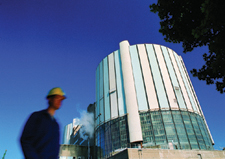 Zoom lenses from Rainbow CCTV are being deployed following the development of previous camera usage at Oldbury, a nuclear power station in Gloucestershire.
Zoom lenses from Rainbow CCTV are being deployed following the development of previous camera usage at Oldbury, a nuclear power station in Gloucestershire.
As part of its remit to ensure that the plants work properly and are safe to operate, British Nuclear Group Reactor Sites perform detailed observations inside nuclear reactors using specially-built manipulators and robots. The procedures allow the company to meet criteria set by an external body, the Nuclear Installations Inspectorate.
The 8-80mm Rainbow zoom lenses function from manipulators on multi-articulated limbs and use a racking focus setup. The client required a three-motor function control lens as opposed to a galvanometer on the iris for speed and chose the lens accordingly.
Eric Jarrett, an electronic engineer with BNG Reactor Sites, said: "Despite extensive testing we could not know with 100% certainty the effect of radiation on the performance and lifetime of the camera. So far the units have spent 18 continuous days inside the reactor. They have functioned without a single fault and allowed us to perform the inspections two days quicker than planned."
Installers who are familiar with racking focus will know that refocusing between far and close objects often only occurs a few times before the operator loses his infinity focus point. BNG Reactor Sites have addressed this problem by creating electronic circuitry which brings the user back to a datum point at the touch of a button.
Operators perform the inspections while working on the power plant's pile cap which is approximately 50 feet above the reactor core with communication coming along the arm from umbilicals. The images are observed in real time and also recorded to digital DVRs and tape.  Eric Jarrett continued: "We demand good reliability from the CCTV equipment. With high out-of-running costs you can't afford to lose time while you fix a lens, camera or VCR. Our experience is that you get what you pay for from quality brands."
Eric Jarrett continued: "We demand good reliability from the CCTV equipment. With high out-of-running costs you can't afford to lose time while you fix a lens, camera or VCR. Our experience is that you get what you pay for from quality brands."
Oldbury Power Station started electricity generation in 1967 and will cease operations at the end of 2008. At that point fuel will be progressively removed from the reactors and sent to Sellafield for treatment, a process that is expected to take three years.
The first commercial nuclear stations in the UK were of the Magnox type named after the magnesium alloy used in the process. Magnox reactors employ natural uranium metal as the fuel, have a graphite moderator and use pressurised CO2 as the coolant.
Rainbow at nuclear reactor
- Related companies
- Rainbow CCTV
- Related categories
- Digital video recorders (DVRs)
- VCRs
- CCTV camera lenses
- View all news from
- Rainbow CCTV
Related videos
In case you missed it

Retailers now often find themself in a precarious situation. Profit margins are being squeezed by widespread shoplifting: The Council on Criminal Justice reports that between the f...

Technology advances in the security industry are transforming the way modern systems are designed and installed. Customers today are looking for greater scalability and flexibility...

The Buffalo and Erie County Naval & Military Park, in Buffalo, N.Y., has a clear mission based on four pillars: to honour all veterans, educate the public about the sacrifices...
Using artificial intelligence (AI) to automate physical security systems
DownloadA modern guide to data loss prevention
Download7 proven solutions for law enforcement key control and asset management
DownloadThe truth behind 9 mobile access myths
DownloadAccess control system planning phase 2
Download












